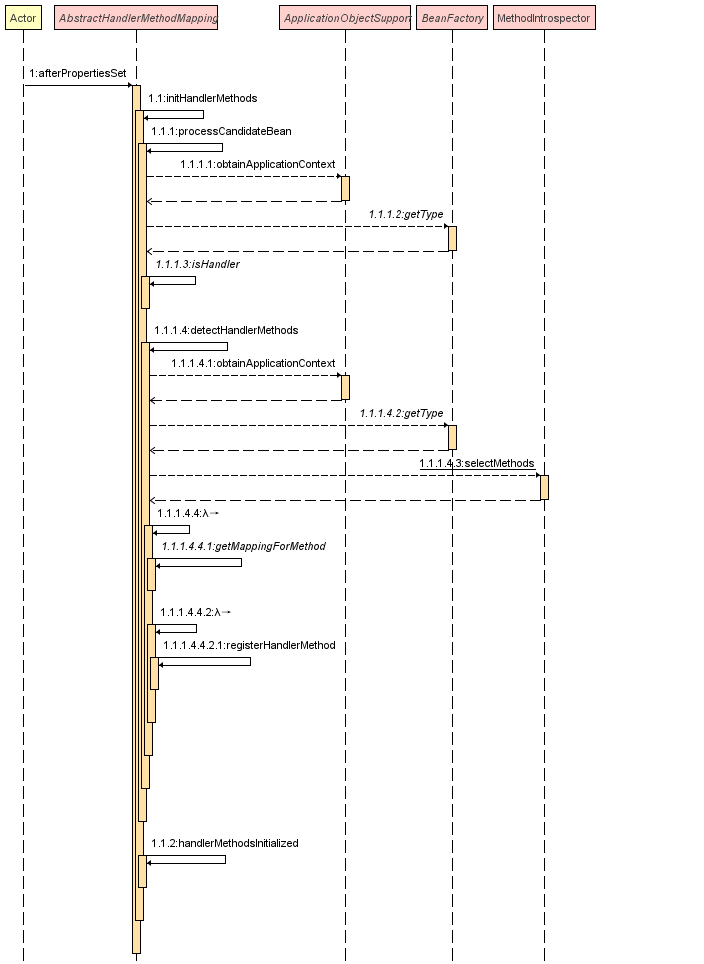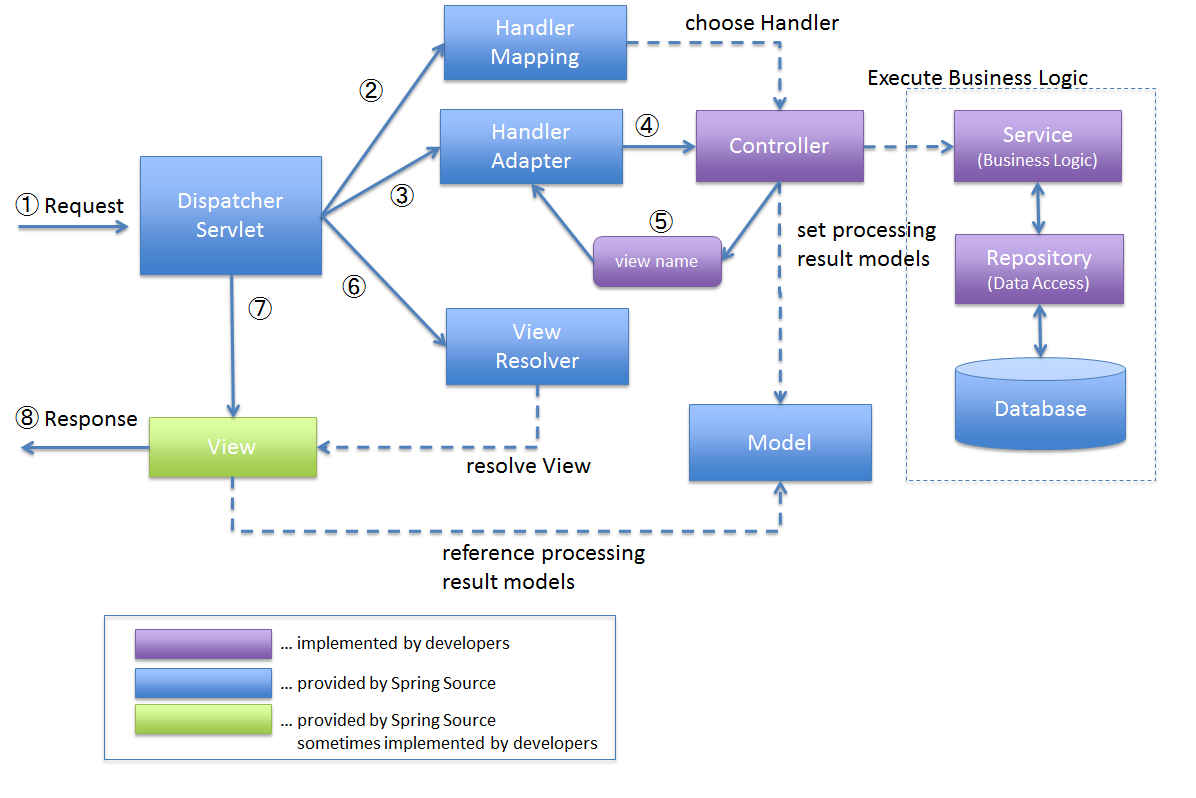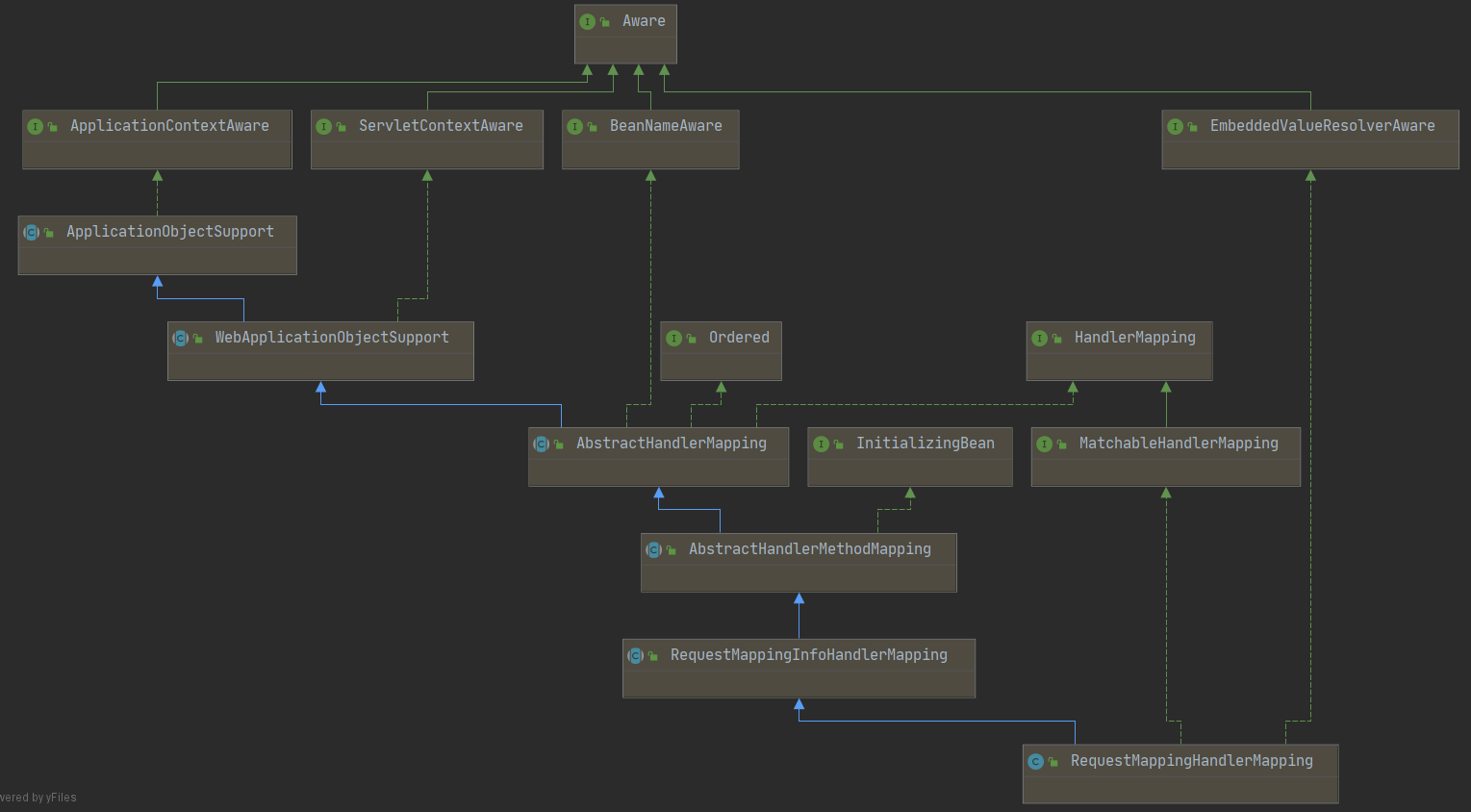RequestMappingHandlerMapping 介绍
RequestMappingHandlerMapping是SpringMVC中的一个重要组件,作用是扫描@Controller、@RequestMapping注解修饰的类,然后生成请求与方法的对应关系,当有一个 HTTP 请求进入 SpringMVC 时,就会通过请求找到对应的方法进行执行。
可以简单的想象一下,在RequestMappingHandlerMapping会维护一个Map<String,Handle>,key 存放的是URI,value 存放的是对应处理的handle,例如:
1 | map.put("GET /user",UserController#get) |
这样通过解析请求就可以很快的找到对应的方法去执行,当然 SpringMVC 的实现肯定不会像上面一样这么简单,不过思路是差不多的。
加载流程
- 流程图

RequestMappingHandlerMapping实现了InitializingBean接口,在应用启动时会触发afterPropertiesSet方法。在
initHandlerMethods方法中,会遍历所有候选的 Bean,并通过processCandidateBean方法进行处理。- AbstractHandlerMethodMapping.java
1
2
3
4
5
6
7
8
9
10protected void initHandlerMethods() {
//遍历所有候选的Bean name
for (String beanName : getCandidateBeanNames()) {
if (!beanName.startsWith(SCOPED_TARGET_NAME_PREFIX)) {
//处理Bean name
processCandidateBean(beanName);
}
}
handlerMethodsInitialized(getHandlerMethods());
}在
processCandidateBean方法中,会通过isHandler判断Bean是否为@Controller、@RequestMapping注解修饰的类,是的话调用detectHandlerMethods来检查类中的Handler methoddetectHandlerMethods中会遍历类中所有方法,通过getMappingForMethod方法筛选出@RequestMapping注解修饰的方法,然后解析成method->mapping的 Map 结构存起来,再遍历使用registerHandlerMethod方法注册到 SpringMVC 中- AbstractHandlerMethodMapping.java
1
2
3
4
5
6
7
8
9
10
11
12
13
14
15
16
17
18
19
20
21
22
23
24
25
26
27
28protected void detectHandlerMethods(Object handler) {
Class<?> handlerType = (handler instanceof String ?
obtainApplicationContext().getType((String) handler) : handler.getClass());
if (handlerType != null) {
Class<?> userType = ClassUtils.getUserClass(handlerType);
//查询Class中的方法
Map<Method, T> methods = MethodIntrospector.selectMethods(userType,
(MethodIntrospector.MetadataLookup<T>) method -> {
//通过匿名内部类的方式来进行method的过滤,没有通过@RequestMapping修饰的方法会返回null
try {
return getMappingForMethod(method, userType);
}
catch (Throwable ex) {
throw new IllegalStateException("Invalid mapping on handler class [" +
userType.getName() + "]: " + method, ex);
}
});
if (logger.isTraceEnabled()) {
logger.trace(formatMappings(userType, methods));
}
//遍历methods进行注册
methods.forEach((method, mapping) -> {
Method invocableMethod = AopUtils.selectInvocableMethod(method, userType);
registerHandlerMethod(handler, invocableMethod, mapping);
});
}
}- 通过
registerHandlerMethod将对应的关系存放到mappingRegistry对象中,里面有很多的 Map 用于存储映射关系
- AbstractHandlerMethodMapping.java
1
2
3
4
5
6
7
8
9
10
11
12
13
14
15
16
17
18
19
20
21
22
23
24//封装HandlerMethod,实际上就是bean name+method,在拦截器中就是暴露的这个对象
HandlerMethod handlerMethod = createHandlerMethod(handler, method);
validateMethodMapping(handlerMethod, mapping);
//将mapping对象和handlerMethod关系存放至mappingLookup
this.mappingLookup.put(mapping, handlerMethod);
List<String> directUrls = getDirectUrls(mapping);
for (String url : directUrls) {
//将非通配符形式的路径与mapping对象关系存放至urlLookup
this.urlLookup.add(url, mapping);
}
String name = null;
if (getNamingStrategy() != null) {
name = getNamingStrategy().getName(handlerMethod, mapping);
addMappingName(name, handlerMethod);
}
CorsConfiguration corsConfig = initCorsConfiguration(handler, method, mapping);
if (corsConfig != null) {
this.corsLookup.put(handlerMethod, corsConfig);
}
this.registry.put(mapping, new MappingRegistration<>(mapping, handlerMethod, directUrls, name));通过源码可以得知,目前有这两个
mappingLookup和urlLookup对象存放了请求映射关系,在请求到来的时候就会通过这两个Map去寻找要执行的方法。
请求流程
先上一张 springMVC 流程图:
入口由DispatcherServlet统一接管,然后通过上一步生成好的HandlerMapping映射关系来查找请求对应的处理方法。
- DispatcherServlet.java
1 | // 寻找当前请求的处理方法 |
在getHandler方法中就是对应的逻辑了,代码如下:
1 | protected HandlerExecutionChain getHandler(HttpServletRequest request) throws Exception { |
这里值得一提的是handlerMappings是一组HandlerMapping接口的实现,SpringMVC默认提供的是org.springframework.web.servlet.mvc.method.annotation.RequestMappingHandlerMapping,如果有需要我们也可以自定义一个HandlerMapping实现来处理请求。
接着一路跟踪源码,直到AbstractHandlerMethodMapping#lookupHandlerMethod(String lookupPath, HttpServletRequest request)方法,就可以看到具体的实现了。
- AbstractHandlerMethodMapping.java
1 | //先直接使用URI进行匹配,适用于没使用通配符修饰的接口路径,对应urlLookup |
至此与 RequestMappingHandlerMapping 有关的请求流程就已经介绍完了,最后再附上一张类图:

大部分的实现逻辑都在父类AbstractHandlerMethodMapping中。
自定义 RequestMappingHandlerMapping
终于步入主题了,在了解RequestMappingHandlerMapping的大概的原理之后,就很清楚的如何来魔改RequestMappingHandlerMapping。
需求
项目中有一个BaseController基础类,当有新的需求开发时只需要继承该类就会拥有对应的CRUD接口,例如:
- BaseController.java
1 | public class BaseController<T> { |
- AppController.java
1 |
|
这样AppController就拥有了基本的CRUD接口功能,但是在某些情况的时候我需要屏蔽掉某个接口,可以通过重写方法来实现:
- AppController.java
1 |
|
这样实现其实也没啥问题,不过会占用一个路由,如果想重写这个接口,并且返回不同的响应体,就实现不了了,例如:
- 重写父类方法编译不通过,因为泛型不兼容
Result<App>!=Result<AppDetailDTO>
1 | //返回特殊的AppDetailDTO |
- 屏蔽父类接口,并声明一个新的方法来实现
1 | //屏蔽get接口 |
通过重新定义一个新的路由来实现,虽然说可以达到目的,但是感觉不够优雅,/{id}路由白白就浪费了,这个时候就只能通过自定义RequestMappingHandlerMapping来实现了。
思路
通过上面的分析可以得知,在应用启动时RequestMappingHandlerMapping会去扫描所有的handle进行关系映射,可不可以实现一个注解,在扫描某个方法时,如果有该注解修饰的时候就跳过。
根据源码可以得知getMappingForMethod,是扫描method的处理入口,方法签名如下:
1 | protected RequestMappingInfo getMappingForMethod(Method method, Class<?> handlerType) |
这个方法可以拿到Method,只有重写该方法并且判断Method上有自定义的注解修饰直接返回 null 就可以达到取消路由注册的目的了。
实现
定义一个@Disable注解,用于标识方法不进行路由注册:
1 |
|
通过实现WebMvcRegistrations接口来自定义RequestMappingHandlerMapping类,并重写getMappingForMethod方法:
1 |
|
这样之前的需求就可以解决了:
1 | //屏蔽get接口 |
父类的方法用@Disable注解修饰了,SpringMVC 并不会加载这个路由,在项目重启的时候就不会报错提示有两个相同的路由存在。
总结
不要为了看源码而看源码,而是带着问题去看框架的源码才是有意义的。


